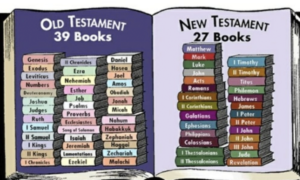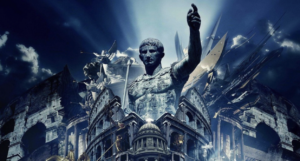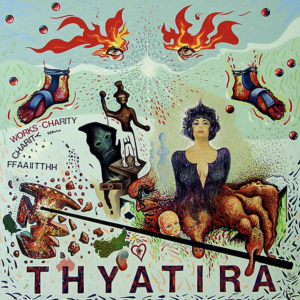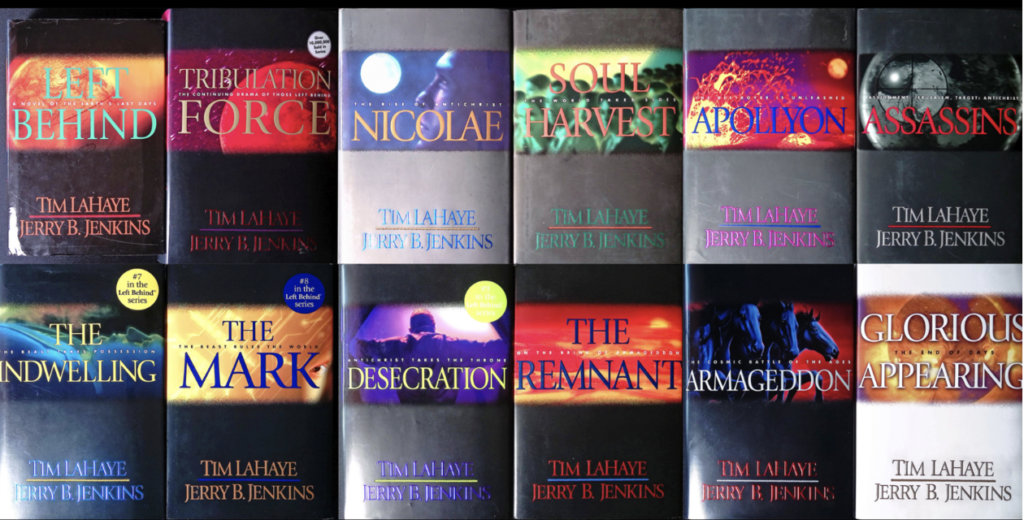
Have you heard of the Book of Revelation?
Well, may be aware of it but seldom is it unread or unpacked. I’d like to start with a quote from Luke Timothy Johnson :
“Few writings in all of literature have been so obsessively read with such
(Johnson, TWoNT, p573)
generally disastrous results as the Book of Revelation.”
Oh, bit of a warning there then…Let’s not immediately buy into the rationale that it is a blueprint for us, as it evokes some startling imagery about the end times – but remember that the author of Revelation thought that it would be soon for them. What is said in Revelation is dictated from Christ himself to John (via an Angel), addressing readers of his own time with a message they had to learn.
“We might be one who can build that bridge for those who are marginalised, who can help those opposing to see the other side. What we should not do is to look at this text from the eyes of powerful, the ones who have control, like the rulers at that time, whether the Romans or those in the 7 Churches.”
Focusing in upon the first 3 chapters of Revelation this week – we can look at the reminder of the text over the next 3 weeks. Rather than read all three chapters which we will be considering today, I offer snippets of reflection from various passages, leaving you to read the Chapters if you so wish.
Who wrote it may be a good place to start?
The obvious answer would be John – but which John? The John the Baptist variety would have been dead a while; John, the son of Zebedee, was one of the disciples and so the text crosses him out as it says he wasn’t one of the 12; and John the Elder seems unlikely given the focus here is Ephesus. Furthermore, in Chapter 4, the author sees 24 elders, thought to represent the 12 patriarchs of Israel and the 221 apostles of Jesus – so the author isn’t seeing himself.

The author of the Fourth Gospel, ‘John’ is also unlikely. If so surely we would have a link between his Gospel and the Book of Revelation, such as we do with Luke and Acts. The way of writing is very different as John’s Gospel is ‘what is happening now’ (then), whereas Revelation is very much about the future. His grammatical Greek is also very poor indeed. Was he a refugee, explaining his weak grasp of the language? In John’s Gospel the “other” are the Jews, whereas in Revelation they are Gentiles. Whoever ‘John’ is, he is a Jew.
This Book is called Apocalyptic: “something which brings comfort to those under pressure or during some form of persecution”. It has been suggested that this was written at the end, or just after, the reign of Emperor Domitian (81-96AD), one who wanted to wipe out Christianity: systematically persecute the whole Church. Though historians aren’t able to find lots of evidence of such persecution. The Book of Revelation was freely circulating for many centuries before the evolved church found itself able to create what we know call the New Testament in 323AD and later – and Revelation was one of the last Books to be accepted, as it was considered ‘extreme’.

Who is it aimed at?
Revelation may be directed towards those who are lukewarm in their faith. It seems Rome and the Church, as it was then, were on a direct collision course. Who do the people worship: Caesar or Jesus? Perhaps that’s the overall key, who is going to win? So as we enter this Book, we don’t just read it but we delve deep into the visual sensory experience, reflect upon the abundance of symbols and try to hear that voice. A voice of one who is imprisoned and expecting great persecution – not where we might be in Glasgow or wherever. This is John’s visionary experience, and he is told not to seal the scroll:
He is writing for the present time ~ circa 100-120 AD? or do you believe it is for now?
Rev 1:1-3 – What has been hidden may now be revealed and we shall see the purpose of God as the time is right for God to act. You can see that it might be a great encouragement to those of that time.
Rev 1:4-8 – Here we see the mention of seven: and numerology is a key aspect in apocalyptic literature. Often the codes of this ‘science’ have been lost as you would have known at the time what it meant. Was it the number of letters from Paul circulating at that time, or to challenge the memorial to the Emperor Domitian’s son which was portrayed with the infant Zeus playing with seven stars; or an indication of wholeness, as in days of the week. We have seven seals, seven trumpets, a battle between the Church and a dragon, seven plagues and then certain victory.


Rev 1:9-11 – Where are we? We are at the Labour Camp of the Romans at Patmos. This exile was sharing in the sufferings of Christ – as Emperor Domitian wanted everyone to worship Caesar as Lord and God – really conflicting with the Christian faith. They were fearful of the expected persecution, so this Book offered support to resist that fear.
Rev: 1:12-20 – The Risen Jesus is portrayed with the people, among the churches. No longer that idea that he has disappeared at Ascension and only will return at the End. The Resurrection is now seen not as eternal life which Jesus had at the start of John’s Gospel (John 1:1), but he is now in a victorious life where death has been conquered. Jesus has conquered the greatest enemy of them all. The Son of Man description harks back to Daniel 10. Where in Aramaic it could mean ‘a human being Son of Man, or “bar-nasha”: John depicts this as Jesus: all scriptural hope as one. Death and Hades (Sheol for the Hebrews) was then seen under the power of death. Is death the greatest enemy to us now? What do you think? Our Death Café in Pollokshaws meets every second Tuesday at G431LH 12-1pm.

The 7 Churches
Rev Chapters 2-3 – We have either seven letters or one letter written to seven different post codes. It might be entitled : “Can you all withstand persecution?” It is written in love, as the author knows these churches, cares for them. Let’s have a quick tour of the 7 churches.
Ephesus, that most important seaport, which by the end of the 1st C was a focal point for Christian literature. The folk there were strong in faith, able to withstand false claims of apostles but lacked love. They so detested heresy they had become inquisitorial, not loving.
Smyrna was also a great seaport, eventually eclipsing Ephesus. Here, it wasn’t just the Romans who were a threat but the Jews, for they resented the Gentiles converting to Christianity – mainly due to the thought of circumcision. The Jews are seen as the Synagogue of Satan. It is important to remind ourselves that we are in the midst of 1st/2ndC syncretism beliefs were very evident. Zoroastrianism depicts a heavenly struggle between the Spirit of Light and Darkness, of God and Satan.
Pergamum was the capital of an independent state and a seat of the Roman Government – possibly whey John cites this place as where Satan has his throne. Pergamum also is the place for the god Asclepius, who we purportedly met one of its believers in Acts 3, a god of healing. Here believers were tempted by worship to sexual gods, or eating food sacrificed to idols – but then again all meat was sacrificed to pagan gods and all coins had imperial pagan symbols. Caesar wanted absolute obedience, no compromise.

Thyatira was a wonderful trading centre with numerous markets. Possibly there was a sect with a prophetess – maybe a forerunner of the Gnostics who claimed a special knowledge of God, and this caused many problems. John is Elijah to Jezebel, so John challenges those in Thyatira to choose between Christ and Satan. The city of Thyatira was known its worship unto the sun god Apollo. The city would participate in drunken and immoral feasts as part of their labour unions. Those who refused to participate in such activities would often lose their jobs for doing so. There was tremendous temptation towards those in the church.
Sardis had a strong fortress but which had fallen twice due to stealth not a direct on attack. It had been complacent – as was the church. This was a dead church, but importantly one that was seen as ok from the outside. As a whole, they are lifeless, but there are sparks of opportunity. Their names would be in the Book of life because of the love of Christ.
Philadelphia –no, not the cheese spread – was a much newer city albeit had been destroyed in 17AD by an earthquake. The people had rebuilt the place twice but were still afraid of what might happen again, so they lived outside the city. The Jews ‘Satan’s Synagogue’ had rejected Jesus but they had the key of David which could unlock the doors of the Church, allowing a two way flow.
Finally Laodicea , a town near to Colossae, which was a banking centre with a textile industry. It also contained a medical centre producing ear ointment and eye salve. The Church survived the earthquake of 60AD, which devastated Colossae, but ran itself like a commercial business. They had banks but were poor in the things of God; they had medical prowess, but were blind; they could produce fine textiles, but stood naked in front of God. There was thought that they had need of water from Hierapolis and so took water which was both cold and tepid ~ lukewarm? But many scholars now feel that it was in light of their medical prowess – you might disagree – that tepid water might make you vomit, curing a condition possibly.
The main thrust of the Book of Revelation is now evident: Jesus will come back and fulfil his promise and be with his people. The imagery may be cosmic but in essence they are : pastoral, practical and personal. Bit like Paul’s letter to the Thessalonians? What’s the message from the author of Revelation?
But what about the Rapture?

Often, as seen in the Left Behind films and books (above – do you remember them?), we are asked to consider the “Second Coming”, something never mentioned within Revelation. The Rapture movement originated from the 1830s by John Nelson Darby in Plymouth, UK. The Brethren spread across the UK and US. They believed that time was set into periods where people worshipped and obeyed God differently. Of the 7 periods there would be a time when Christ returned twice. Historically, many have tried to determine the date of this rapture from various verses, linking ‘one day is but a thousand years’. Pamphlets were produced about the Fundamentals of Christianity: fundamentalism : but not from Revelation.
The nature of the Revelation text sweeps up all of those who hear this message and asks them to be transformed into a new way of life. The emphasis upon the time on nigh is reflecting that the time of Roman domination may be near to its close, and not for today. That wasn’t true as their domination would exist for a few more centuries. There were many other books ‘released’ at such a time: 1 Enoch, 4 Ezra, the Ascension of Isaiah : all mystical and visionary. Paul, the self-declared apostle, speaks of a visionary experience in 2 Cor :1-4. It wasn’t that uncommon back then. When we hear of the harsh responses from some of the churches to the persecution we might bristle at their tone. Nevertheless, perhaps here is the message for us today.
And Now?
Let’s look at what we have heard through the lens of the marginalised, the persecuted. How many of us truly know what it might be to live in persecuted times? But if we did, would Revelation make more sense? The author was well known to each of the 7 churches. He desperately wanted to convey the love of God to them, but deliver it in mystic and complicated graphic imagery.
It wasn’t a simple situation, with churches vying with other societal desires – very much like today. The fiery responses against those who disagree with us may be something we want to do: whereas, Jesus is calling for us to find that opportunity to be that bridge builder. We might be one who can build that bridge for those who are marginalised, who can help those opposing to see the other side. Might we see us as that bridge builder? But with whom? How can we see the situation through the eyes of the powerless, unless we sit with them, be alongside them?
So is Revelation a blueprint for us? No. Revelation is no blueprint for our life, as the author is suggesting that what might happen will be quick – not 2000 years later. We may still draw inspiration from this apocalyptic book to help us with today – if we strive to have that perspective. What we should not do is to look at this text from the eyes of powerful, the ones who have control, like the rulers at that time, whether the Romans or those in the 7 Churches. Exactly, where are we today?
I found the dialogue interesting and I enjoyed it